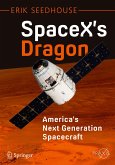CHAPTER 1: INTRODUCTION 1 From the Ground Up 3 Rockets and Satellites 4 To the Moon 15 Humans versus Robots 18 CHAPTER 2: A SPACE ROBOT IS BORN 23 Scientific Conception 25 Proving Technology 33 The Political Push 36 Paper Spacecraft 38 It'sJust a Phase I'm Going Through 48 CHAPTER 3: ANATOMY OF A SPACE PROBE 53 Bits and Pieces 55 Power 57 Vll Contents Communication 65 Structures 70 Thermal Control 73 Attitude Control 77 Propulsion 86 Data Handling 89 Mechanisms 93 The Kidnap ofLuna 1 95 CHAPTER 4: BUILDING AND TESTING 97 The Spacecraft Garage 97 Keep it Clean 100 Planetary Protection 102 Shake, Rattle 'n' Roll 108 Shaken, not stirred 110 Canned space 112 Antenna testing 112 Special cases 113 Breaking the software 114 CHAPTER 5: INSTRUMENTS OFS CIENCE 115 The More we Learn, the More we Don't Know 116 Let's get Physical 118 It's All in the Data 121 Many Eyes 122 123 Visible light instruments There is more than meets the eye 126 Messenger's Instruments 129 Roving Around 132 Diving through an Atmosphere 140 142 Primeval soup Going down 142 CHAPTER 6: LAUNCH 149 On the Road 149 Spaceports 150 Preparing for Launch 153 Up and Away 156 Rockets 159 162 Orbits Vlll Contents CHAPTER 7: DISTANT DESTINATIONS 167 To the Moon 170 The first visits 170 Preparing for Apollo 172 Robot rovers 175 Modern missions 176 A new Moon 177 Unromantic Venus 179 Greenhouse nightmare 179 Into the unknown 180 Magellan 186
From the reviews:
"Michel van Pelt in his book ... provides a practical look at these amazing machines that travel ever further from our home base on Earth. ... the reader can well appreciate the effort that goes into ensuring that robots can acquire the most useful information. van Pelt enhances this distillation by using a simple writing style with little specialized nomenclature. Thus, the book is well suited to youths, young adults and those with a general interest." (Universe Today, May, 2007)
"This includes an historical introduction, an overview of the major successful and unsuccessful missions, and an attempt to anticipate some of the new technologies that may be introduced in the future. All of this is well written and easy to follow, though much of it was fairly familiar. ... this is a worthwhile read for anyone seeking a behind-the-scenes look at what goes on in those research centers and clean rooms where our robotic ambassadors are created and tested ... ." (Peter Bond, BBC SkyatNight, June, 2007)
"In Space Invaders, Michel van Pelt, a cost and systems engineer with ESA, walks the reader through the steps needed to design, develop, and launch a planetary mission. ... The book is written for people who are not necessary familiar with space exploration, so there's some basic explanatory material in the book about orbits and rocket design. However, van Pelt provides plenty of more detailed information as well." (Jeff Foust, The Space Review, June, 2007)
"Van Pelt discusses unmanned space missions, which he calls robotic missions carried out by robotic spacecraft. ... it will be useful to the general reader interested in learning about unmanned space exploration missions (US, European, and Russian) in all their complexity, in a chatty, somewhat amusing manner. It will also be useful to undergraduates who need an introduction to 'robotic' space exploration. Summing Up: Recommended. General readers; lower-andupper-division undergraduates; two-year technical program students." (A. M. Strauss, CHOICE, Vol. 44 (10), June, 2007)
"Michel van Pelt in his book ... provides a practical look at these amazing machines that travel ever further from our home base on Earth. ... the reader can well appreciate the effort that goes into ensuring that robots can acquire the most useful information. van Pelt enhances this distillation by using a simple writing style with little specialized nomenclature. Thus, the book is well suited to youths, young adults and those with a general interest." (Universe Today, May, 2007)
"This includes an historical introduction, an overview of the major successful and unsuccessful missions, and an attempt to anticipate some of the new technologies that may be introduced in the future. All of this is well written and easy to follow, though much of it was fairly familiar. ... this is a worthwhile read for anyone seeking a behind-the-scenes look at what goes on in those research centers and clean rooms where our robotic ambassadors are created and tested ... ." (Peter Bond, BBC SkyatNight, June, 2007)
"In Space Invaders, Michel van Pelt, a cost and systems engineer with ESA, walks the reader through the steps needed to design, develop, and launch a planetary mission. ... The book is written for people who are not necessary familiar with space exploration, so there's some basic explanatory material in the book about orbits and rocket design. However, van Pelt provides plenty of more detailed information as well." (Jeff Foust, The Space Review, June, 2007)
"Van Pelt discusses unmanned space missions, which he calls robotic missions carried out by robotic spacecraft. ... it will be useful to the general reader interested in learning about unmanned space exploration missions (US, European, and Russian) in all their complexity, in a chatty, somewhat amusing manner. It will also be useful to undergraduates who need an introduction to 'robotic' space exploration. Summing Up: Recommended. General readers; lower-andupper-division undergraduates; two-year technical program students." (A. M. Strauss, CHOICE, Vol. 44 (10), June, 2007)









